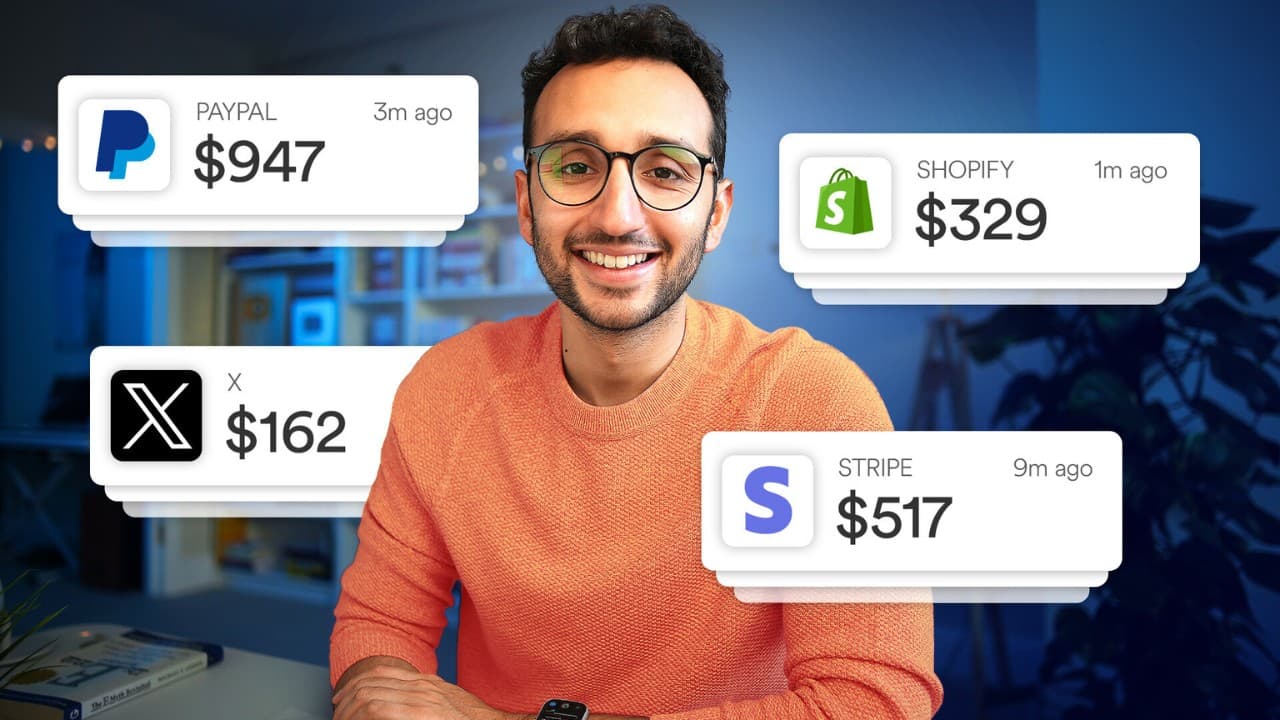6 Side Hustles Students Can Start in 2023
17 Nov 2023 (2 years ago)

Introduction (0s)
- Side hustle ideas for students are applicable to non-students as well.
- There is no magic way to make money; success comes from providing value to those willing to pay for it.
- Understanding the skill of making money allows for the application of principles in various contexts.
- This leads to the possibility of teaching others about making money in the future.
Why are we even talking about this? (1m3s)
- Side hustles are discussed because they can change lives and offer financial freedom.
- Having multiple income streams can provide anti-fragility, particularly important during job market instability.
- Side hustles can unlock the ability to live life on one's own terms.
- The speaker shares personal experiences with side hustles from web design at age 13 to a YouTube channel generating significant income.
- Pursuing side hustles is encouraged, not out of greed, but to create an alternative stream of income.
How to make money as a side hustle? (4m4s)
- Money is earned by providing value to those who are delighted to pay.
- Three vehicles for providing value: Services, Products, and Content.
- The video will focus on two Content and four Service side hustle ideas, omitting Product-based side hustles for another discussion.
- Ideal side hustles should offer flexibility, fun, and finance.
- Side hustles should leverage the internet for geographical independence and a potentially global customer base.
- Aiming not to directly replicate others' success but to learn from their principles and apply them to one's own unique skills and circumstances.
Side Hustle 1 (6m34s)
- Writing, particularly newsletters, is a viable side hustle for students.
- An example provided is Jack Reigns, a student from Columbia Business School who started a finance and travel newsletter.
- Jack has tens of thousands of readers and charges approximately $1,400 per ad, with four newsletters a week totaling $5,600 monthly income.
- He also earns from consulting calls, charging $300 for a 45-minute session.
- Writing online has a low barrier to entry; platforms like Substack and Beehive offer free accounts.
- Reaching out to established writers with genuine interest and showing one’s work can lead to mentorship opportunities.
- Consistency in content creation is vital for success; example given is the video host's own weekly newsletter, Sunday Snippets, with about 400,000 subscribers.
- Once earning from side hustles, investing is advised, promoting Trading 212, a commission-free investment app with features like pies (asset baskets) and multi-currency accounts.
Side Hustle 2 (11m6s)
- Becoming a content curator is different from being a content creator; it involves showcasing work others have created.
- Eduardo Morales grew his Instagram account, Pin Lord, to over 100,000 followers, curating enamel pins, generating $3,500 a month.
- Success like Eduardo's requires understanding the platform and long-term effort, in contrast to expectations of quick returns.
- Alex and Books curated book insights, built a following, and monetized without creating original content.
- Content businesses like YouTube are J-curve businesses, with a period of investment before reaching a profit inflection point.
- Non-J curve businesses, often service-based, can generate immediate income without the initial negative investment phase.
- Low-friction sales processes are more likely to be J-curve businesses, while service businesses often have high-friction processes involving client interaction and persuasion.
Side Hustle 3 (16m59s) & Side Hustle 4 (19m27s)
- A profitable service-based side hustle is thumbnail designing for YouTubers.
- Example: Dill Tomah turned thumbnail design into a full-time job, charging up to $250 per thumbnail with a significant monthly income.
- Matt Brighton made over $10,000 on Fiverr by designing thumbnails for YouTubers.
- To attract YouTuber clients, improve their existing thumbnails, matching their brand style.
- There is high demand for thumbnail designers; the key is to develop and offer quality design skills.
- Being a research assistant is another side hustle, particularly for authors and content creators.
- Drew Bernie became Mark Manson's research assistant by spotting a hiring opportunity and demonstrating compatibility with required skills.
- Billy Oppenheimer secured a position as Ryan Holliday's research assistant through an effective cold email that made it easy for Holliday to say yes.
- Content creators and authors often require research assistance, offering opportunities for those skilled at internet research and analysis.
Side Hustle 5 (21m12s)
- Being a remote sales representative involves selling products to customers via phone or Zoom.
- Companies pay commissions for each product sold by a remote sales rep.
- An example given is Wouter Tuijnman, a Dutch student who offered thumbnail advice, landed an internship, and sold $250,000 in ads in 60 days.
- This role suits people who enjoy engaging with others and have a talent for sales.
- Unlike traditional on-location sales roles, remote sales can be done while studying or working from home.
- Specific training for remote sales rep positions is available through various online resources, but not covered within the video.